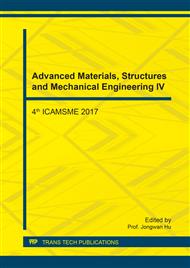[1]
L. Y. Gomez-Zamorano, E. Vega-Cordero and L. Struble, Composite geopolymers of metakaolin and geothermal nanosilica waste, Constr. Build. Mater. 115 (2016) 269-276.
DOI: 10.1016/j.conbuildmat.2016.03.002
Google Scholar
[2]
Z. H. Zhang, H. J. Zhu, C. H. Zhou and H. Wang, Geopolymer from kaolin in China: An overview, Appl. Clay Sci. 119 (2016) 31-41.
DOI: 10.1016/j.clay.2015.04.023
Google Scholar
[3]
Y. H. Liew, C. Y. Heah, A. M. Mustafa Al Bakri and H. Kamarudin, Structure and properties of clay-based geopolymer cements. A review, Prog. Mater. Sci. 83 (2016) 595-629.
DOI: 10.1016/j.pmatsci.2016.08.002
Google Scholar
[4]
P. Nath and P. K. Sarker, Use of OPC to improve setting and early strength properties of low calcium fly ash geopolymer concrete cured at room temperature, Cem. Concr. Comp. 55 (2015) 205-214.
DOI: 10.1016/j.cemconcomp.2014.08.008
Google Scholar
[5]
H. Wang, H. Li and F. Yan, Synthesis and mechanical properties of metakaolinite-based geopolymer, Coll. Surf. -A Physicochem Eng. Asp. 268 (2005) 1–6.
Google Scholar
[6]
R. A. Robayo-Salazar, R. M. de Gutiérrez and F. Puertas, Effect of metakaolin on natural volcanic pozzolan-based geopolymer cement, Appl. Clay Sci. 132-133 (2016) 491-497.
DOI: 10.1016/j.clay.2016.07.020
Google Scholar
[7]
C. Y. Heah, H. Kamarudin, A. M. Mustafa Al Bakri, M. Bnhussain, M. Luqman, I. Khairul Nizar, C. M. Ruzaidi and Y. M. Liew, Study on solids-to-liquid and alkaline activator ratios on kaolin-based geopolymers, Constr. Build. Mater. 35 (2012).
DOI: 10.1016/j.conbuildmat.2012.04.102
Google Scholar
[8]
H. Y. Leong, D. E. L. Ong, J. G. Sanjayan and A. Nazari, The effect of different Na2O and K2O ratios of alkali activator on compressive strength of fly ash based-geopolymer, Constr. Build. Mater. 106 (2016) 500-511.
DOI: 10.1016/j.conbuildmat.2015.12.141
Google Scholar
[9]
G. Gorhan, R. Aslaner and O. Sinik, The effect of curing on the properties of metakaolin and fly ash-based geopolymer paste, Comp. Part B 97 (2016) 329-335.
DOI: 10.1016/j.compositesb.2016.05.019
Google Scholar
[10]
A. Vásquez, V. Cárdenas, R. A. Robayo and R. Mejía de Gutiérrez, Geopolymer based on concrete demolition waste, Adv. Powder Tech. 27 (2016) 1173-1179.
DOI: 10.1016/j.apt.2016.03.029
Google Scholar
[11]
H. K. Tchakouté, C. H. Rüscher, S. Kong, E. Kamseu and C. Leonelli, Geopolymer binders from metakaolin using sodium waterglass from waste glass and rice husk ash as alternative activators: A comparative study, Constr. Build. Mater. 114 (2016).
DOI: 10.1016/j.conbuildmat.2016.03.184
Google Scholar
[12]
S. O. Sore, A. Messan, E. Prud'homme, G. Escadeillas and F. Tsobnang, Synthesis and characterization of geopolymer binders based on local materials from Burkina Faso – Metakaolin and rice husk ash, Constr. Build. Mater. 124 (2016) 301-311.
DOI: 10.1016/j.conbuildmat.2016.07.102
Google Scholar
[13]
A. I. Badanoiu, T. H. Abood Al Saadi, S. Stoleriu and G. Voicu, Preparation and characterization of foamed geopolymers from waste glass and red mud, Constr. Build. Mater. 84 (2015) 284-293.
DOI: 10.1016/j.conbuildmat.2015.03.004
Google Scholar
[14]
R. M. Novais, G. Ascensão, M. P. Seabra, J. A. Labrincha, Waste glass from end-of-life fluorescent lamps as raw material in geopolymers, Waste Management 52 (2016) 245-255.
DOI: 10.1016/j.wasman.2016.04.003
Google Scholar
[15]
ASTM-C618, Standard Specification for Coal Fly Ash and Raw or Calcined Natural Pozzolan for Use in concrete, (2005).
DOI: 10.1520/c0618-99
Google Scholar


